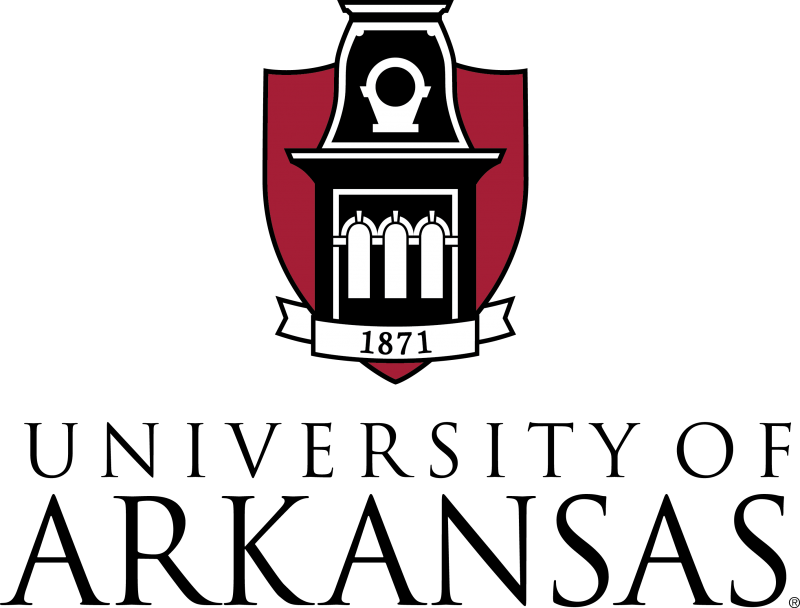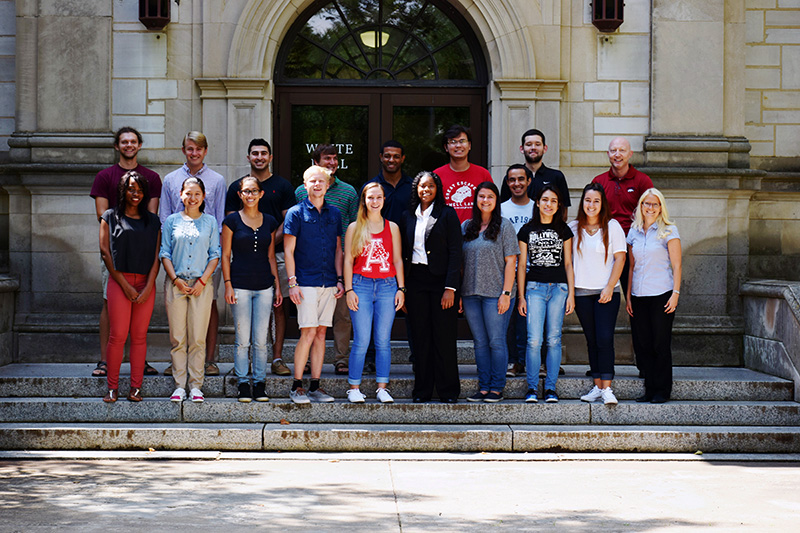When she arrived at the University of Arkansas early this summer, Brazilian undergraduate student Marianna Maisonnette was eager, but nervous. “I felt very excited,” she explained of the research work that lay ahead, “and a little afraid.”
She wasn’t alone. Maisonnette is part of the Summer Research Internship (SRI) program, which has enabled over 70 students to stay on the University of Arkansas campus for ten weeks while working with University faculty. Of the visiting students, 56 are working with engineering faculty members, while 15 are working in exercise science, food science, supply chain, management and physics.

Mitral valve team members Dylan Guimaraes and Mariana Maisonnette, (both visiting SRI students), and Tiffany Lin, a visiting undergraduate student from China. Photo by Laura M. Fickett.
Maisonnette herself is part of a team of nine students, all from Brazil, who worked in the labs of Morten Jensen, associate professor, and Hanna Jensen, research assistant professor. For students like Maisonnette, the chance to do first-hand biomedical research with the Jensens was a major inducement to apply to the SRI program. Explained student Jéssica Belisário, “As a biomedical engineering sophomore, I had never worked in research before…when the opportunity of working with it appeared, I grabbed it.”
For the Jensens, the presence of the Brazilian students was a unique opportunity. Typically, students have a long time frame in which to conduct lab research—graduate students, for instance, can explore every tangent of a given research path over a period of many months, or even years. While many professors might therefore see the SRI students’ ten weeks as problematic, Hanna Jensen saw it as an asset. “The limited timeframe,” she explained, “pushes [the students] to accomplish more.”
Since many of the students were coming from different fields of engineering, and, like Belisário, hadn’t done first-hand research before, their first task at the U of A was to spend a week reading background material. The goal was not just to familiarize the students with biomedical engineering as a discipline, but to prepare them for work on one of four specific teams, each with a different theme: stroke, heart attack, mitral valve, or venous valve. At the end of the first week, the Jensens discussed with the students the specific problems each team would address through their summer work. The stroke team, for instance, was tasked with building a functional blood vessel simulator. Explained Belisário, “There are some models already in the market, but the real purpose of [the stroke team] project is to improve indicators like mortality rate, recanalization rate and procedure duration associated with these devices. As an initial state, our goal this summer was to build a functional blood vessel system [that could] simulate the flow of the the blood through our arteries, also how clots obstruct this flow when a stroke happens…we had to find out the best way to make each single part of this model work well.”

Venous valve team members Garrett Easson, Bruno DaSilva, Juliana Bento, and Mads Andresen. Easson is a graduate student at the U of A, DaSilva and Bento are visiting SRI students, and Adresen is a visiting undergraduate student from Denmark. Photo by Laura M. Fickett.
The projects of the other teams were similarly complex. The heart attack team cultured cardiomyocytes in an effort to introduce cardiac ischemia at will, the venous valve team created an easily implantable prosthetic venous valve, and the mitral valve team built a device capable of discerning whether valves were sick or healthy, and distinguishing live valves from dead ones.
“These activities demonstrate the significant impact our faculty are having on promoting research experiences for students not just in Arkansas, but from different parts of the world. Through these programs, we strive to provide students with opportunities that help them understand the importance of collaboration and to also realize the real impact that biomedical engineering can have on the lives of people in different parts of the world,” said Raj Rao, professor and head of the Department of Biomedical Engineering.
Notably, each group was not tasked with these projects on their own. In addition to the Jensens, each of the four groups also worked with U of A grad students, undergrads, and/or visiting students from other universities. For all parties involved, having more hands on deck was beneficial—U of A students were able to help those who were new, and the new students were able to offer fresh perspectives. Stated Anna Brickell, a U of A undergrad on the heart attack team, “Working in the lab with our grad student made things interesting and enjoyable. I feel each member of our team worked together efficiently and we were able to get more done and learn from one another.”
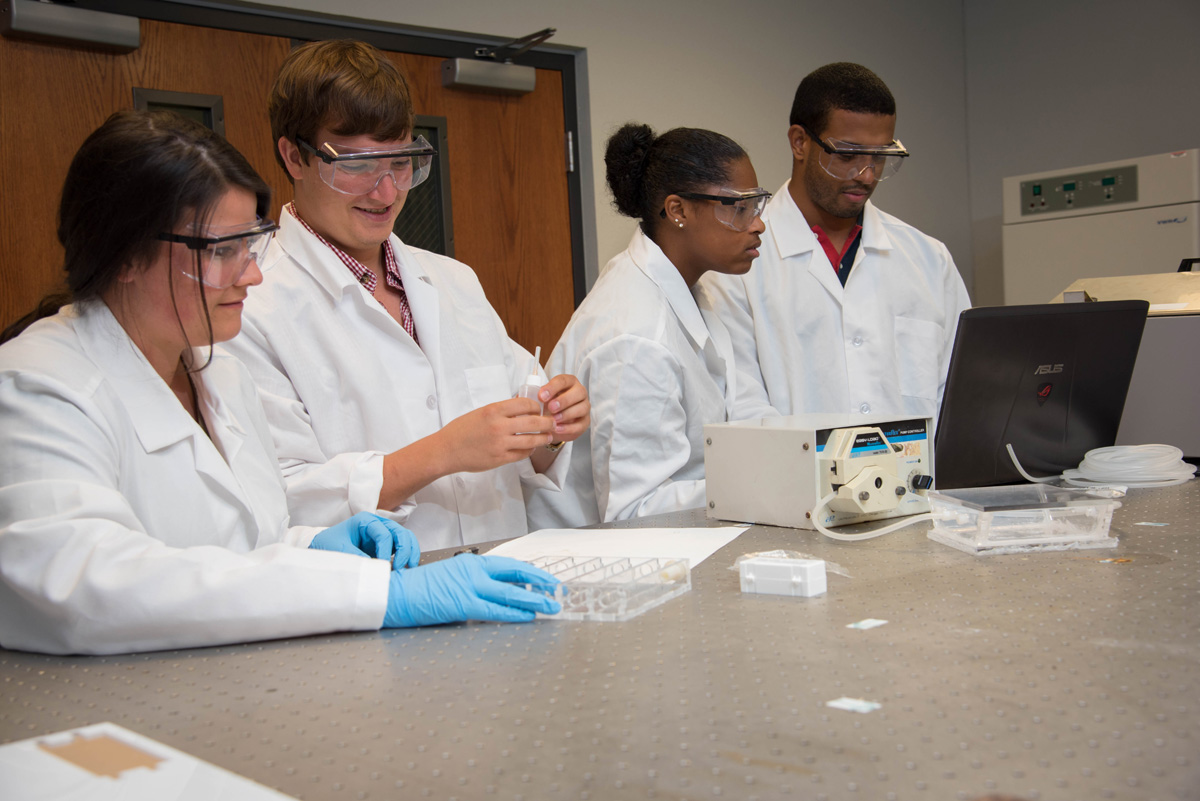
Heart attack team members Anna Brickell, Curran Henson, Dymonn Johnson and Vinicius Sardinha. Brickell is a U of A undergraduate student, Henson is a U of A graduate student, Johnson is a visiting undergraduate student from Jackson State University, and Sardinha is a visiting SRI student. Photo by Laura M. Fickett.
What’s more, the Jensens explained, having students from a wide range of backgrounds as opposed to just biomedical engineering was an asset for each group. “We are trying to solve problems in the human body that are so complex it would be unrealistic to expect one field of expertise to serve.” Hanna Jensen stated. She likened the field of biomedical engineering to the head of an octopus, which requires tentacles in many different disciplines, ranging from medicine to biology to chemistry to mechanical engineering. Morten Jensen continued, “Students are exposed to this type of work and say, ‘Is it really possible a mechanical engineer can come to a graduate degree in BME?’ We tell them: of course! These programs open doors and provide opportunities for international students, sometimes finding themselves having to solve completely new problems with the tools they acquired through their education. The definition of research is to gain new knowledge by setting hypotheses and testing these through specific tests that have never been done before. We need to teach the students to swim. Pushing their boundaries make the water deep enough that returning to shore comes with a great feeling of accomplishment for them.” Jensen’s words proved themselves true in the case of the heart attack team, in which SRI student Vinicius Sardinha, a mechanical engineering major, and Curran Henson, a grad student in biomedical engineering here at the U of A, designed a bioreactor together.
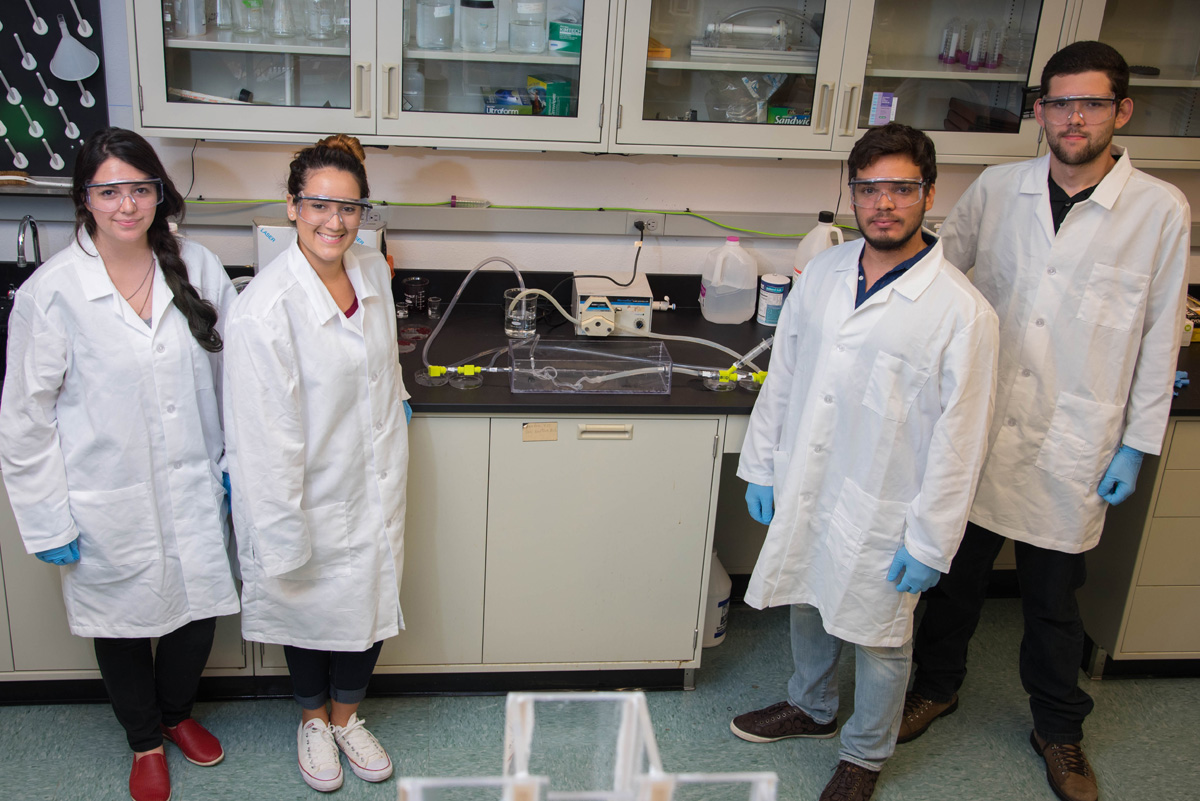
Stroke team members Joyce Alves Gerdulo, Jéssica Belisário, Leandro Azevedo and Matheus Fernandes de Oliveira, all visiting SRI students. Photo by Laura M. Fickett.
Over the course of the summer, one of the most important lessons the SRI students learned was that lab work itself is only part of the research process. Matheus Fernandes, a member of the stroke team, noted that “Something that I…didn’t know before [is] that a big part of the research is to send emails and phone calls to multiple companies and professors for a oddly long period of time to try start the project.” In addition, he explained, “Sometimes one day in the library saves a month in the lab.” Similarly, said Belisário, “Researching is not only about studying what has already been done…Most [of the] time you’re sending emails, scheduling meetings, talking to companies on the phone…Basically contacting a lot of people!”
A second lesson the students learned was how to persist in researching, even when facing roadblocks. The stroke team faced an unexpected setback in the middle of the summer when they had to pause their work to wait for a shipment to arrive. While it would have been easy to use this break as a chance to step back from their research entirely, the team instead chose to spend the newfound time planning ahead. They explored various options, decided on prototypes, and by the time their shipment was delivered, they were able to hit the ground running. In short, Morten Jensen explained, “Attitude and proactivity [were] key factors in their success.” Added Hanna Jensen, “They haven’t been complacent.”
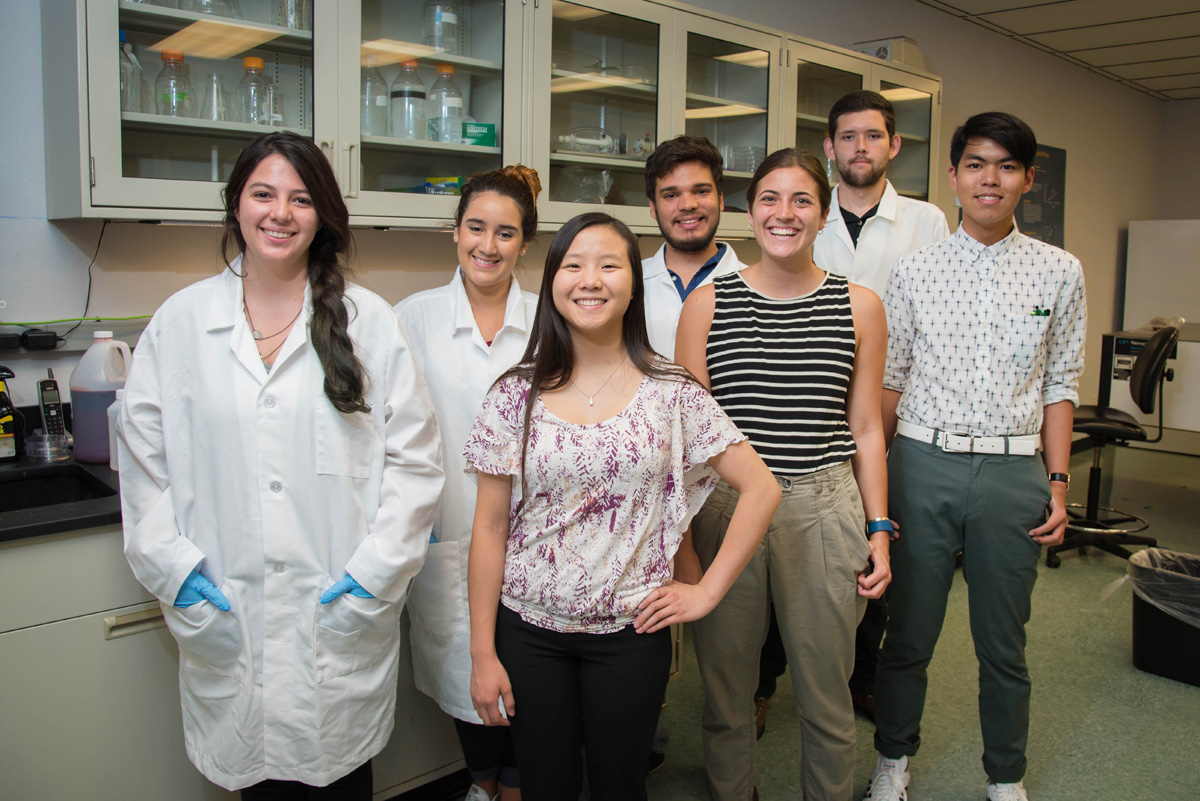
Stroke team members Joyce Alves Gerdulo, Jéssica Belisário, Leandro Azevedo and Matheus Fernandes de Oliveira (all in lab coats) with the students who will continue their research this fall: U of A undergraduate student Chynna Denham, U of A graduate student Anne Meier, and U of A undergraduate student Paolo Garcia. Photo by Laura M. Fickett.
Though the students have now finished their ten weeks at the University of Arkansas, the impact of their time here extends far beyond this summer. For many students, the research they conducted is being continued by others in the months to come. In the case of the stroke team, the research baton was passed quite literally when incoming graduate student Anne Meier arrived late this summer. Meier plans to pick up where the SRI team left off by using the model they created.
In addition, there’s also the chance that the SRI students themselves could return to the U of A. It’s often the case that SRI students are inspired by their time here to apply as graduate students; as Maisonnette explained, this summer “showed me [that biomedical engineering] really is something I enjoy doing and would love to work with in the future. I admire Dr. Jensen a lot and hope to not only work with him again in the future, but also, perhaps, do graduate school here.”
Regardless of whether they choose to return to the U of A, it’s true that all the SRI students are leaving with more confidence in their skills as researchers. When asked how she felt now that the ten weeks here had come to a close, Maisonnette was clear that the nerves she’d experienced early on had diminished. “Now,” she explained, “I see that anything that I don’t know I can learn and deliver it.”
To see photos of the SRI students presenting their summer research, visit the Facebook page of the Biomedical Engineering Department!
